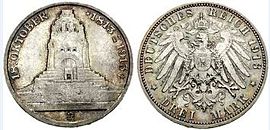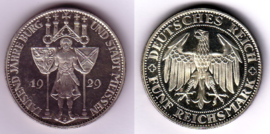Muldenhütten mint

The Muldenhütten mint near Freiberg became the new Saxon state coin after the Dresden mint was closed in 1887. Imperial coins of the Saxon state mint carried the letter E as a mintmark from 1872 . The Muldenhütten mint adopted this mintmark until it closed in 1953.
history
Relocation of the state coin from Dresden to Muldenhütten
After the introduction of the gold standard , coinage reached its peak in 1876. Thereafter, the coin operation subsided. In the years 1882 to 1884 the minting business came to a standstill. In March 1884 it was decided in the first chamber of the state parliament to move the mint to Freiberg and to use the vacated area as a building site for the construction of the new art academy . At the beginning of May 1884 the relocation to the Halsbrücker Hütten was the declared goal, and shortly afterwards Muldenhütten . The coin blanks could advantageously be produced there at the same location in the state ironworks. Relocation for operational reasons had already been considered earlier, but always failed for various reasons.
The last coins from the Dresden Mint were pfennigs . They were minted on February 5, 1887 and delivered on February 7. When the facilities of the Dresden Mint had already been partially dismantled for relocation to Muldenhütten, the incumbent mint master Gustav Julius Buschick (1860–1887) had 25 one-pfennig coins dated 1887 with a large dot after PFENNIG minted as mementos, the “very last one-pfennig”. The new mint started operating in the same year. After the Dresden mint was relocated to Muldenhütten, mint master Buschick retired. The office of mint master was not continued in the new mint. The mintmaster's mark was replaced by the mintmark E as early as 1872 and adopted by the new coin.
The mint until 1953
The minting at the new location began on March 28, 1887. The first coins minted in the new mint were 20-pfennig pieces (copper / nickel) dated 1887, of which the first 50 copies were marked with an asterisk below the value. The star is the mint master's mark of the last Freiberg mint master Andreas Alnpeck (1546–1556) and indicates that the relocation to Muldenhütten is a relocation to the Freiberg area (see Freiberg mint ).
Max Barduleck was a coin engraver, medalist and die cutter at the Saxon State Mint in Dresden and Muldenhütten from 1865 to 1911. His last die cut before retirement was for the minting of the 5-mark commemorative coins on the 500th anniversary of the University of Leipzig in 1909. Friedrich Wilhelm Hörnlein , who already attested his artistic work from 1905 to 1911 with medals and plaques for the Bavarian mint Carl Poellath in Schrobenhausen and for Glaser & Sohn in Dresden, applied in 1911 for the position of the coin engraver Max Barduleck, who had retired for reasons of age. On July 1, 1911, Hörnlein, previously known as an outstanding medalist ( signature mostly F. H.), took over the post of coin engraver at the Royal Saxon State Mint, whose main task was to create the conditions for the proper operation of the coinage . This included not only the cutting dies , but also the revision of the stamp and complementing it with the mint mark E as a label for the coinage in Muldenhütten. Since 1919, the designs and stamps for the imperial coins came almost exclusively from Berlin . Nevertheless, Friedrich Hörnlein also made designs for imperial coins.
The following fronts of the imperial coins were made according to drafts of Hörnlein for the minting in the Muldenhütten mint:
- 3 Mark 1913 E, on the occasion of the 100th anniversary of the Völkerschlacht near Leipzig ( Völkerschlachtdenkmal )
- 3 Mark 1917 E , on the occasion of the 400th return of the Reformation ( Friedrich the Wise )
- 3 and 5 Reichsmark 1929 E, a thousand years of the castle and city of Meissen .
3 Mark 1917 E, 400th anniversary of the Reformation (replica 2001)
For the obverse of the commemorative coin commemorating the 400th anniversary of the Reformation with the bust of Frederick the Wise (1486–1552), Hörnlein used the Schautaler from 1522 minted in the Nuremberg or Zwickau mints as a template (see Locumtenenstaler # coins and medals of Friedrich III. - the other type a commemorative coin from 1522). The imperial coin has a mintage of only 100 copies. Most of them are said to have been melted down again. The 3-mark piece is one of the rarest coins today.
The Hörnlein medals, mostly minted in the Muldenhüttener Mint, testify to the high artistic and technical ability of the medalist to be able to cut his medal designs directly (mirror-inverted and deepened) into the steel die and to do without the reducer.
Friedrich Hörnlein and his family died in the destruction of Dresden on February 13, 1945. At the same time, this marked the end of the extensive and important artistic creation of medals that had a special impact on the Muldenhüttener Mint.
In contrast to Max Barduleck, Hörnlein did not make any records of his artistic work. In many years of research, authors like Max Fischer have tried to capture his work as completely as possible on the basis of the inventory of Hörnlein medals, plaques and coins in the Dresden Münzkabinett .
The Muldenhütten mint ceased operations in 1953. Franz Zapf, director of the Münzkabinett in Dresden from 1959 to 1966 and the then mint management had taken care of the transfer of the valuable furnishings to Dresden, including two minting machines.
With the end of minting in Muldenhütten, the Berlin mint , mint mark A, became the only mint in the GDR.
The end of the mint
The minting operation was discontinued in 1953, but that did not apply to the "Münze Muldenhütten" operation. It was there until December 31, 1961. Drum and packaging tape was now produced under this name. It was not until December 31, 1961 that the legally independent company was dissolved by an instruction from the GDR Minister of Finance. On January 1, 1962, the affiliation to the VEB mining and smelting combine "Albert Funk" Freiberg took place . The employees of the mint up to then were taken over. The combine also took over the facilities, tools and documents that were used to manufacture coins.
The coins of the mint
According to the resolutions of the Federal Council, the mints of the individual German federal states had to realize a certain proportion of the total output in the German Reich. This proportion has been changed several times. According to the distribution plan of December 21, 1888, a share of 7.45% was planned for the Muldenhütten mint. In 1941 it was 6.35% and in 1944, after the failure of the Hamburg State Mint, it was 7%.
- On behalf of the empire:
In the Saxon mint, on behalf of the empire, all denominations were minted in accordance with the Coin Act on the Minting of Imperial Gold Coins of December 4, 1871 and the Law of July 9, 1873. According to the law of July 1, 1900, the Federal Council was authorized to mint commemorative coins. In the Kingdom of Saxony, the aforementioned commemorative coins 2 and 5 marks in 1909, Leipzig University, 3 marks in 1913, the Völkerschlachtdenkmal and 3 marks in 1917, the anniversary of the Reformation. The commemorative coin visits on Zweimark schrötlingen from 1892, 1903 and 1905 with the inscription z. B. MINTED / IN PRESENT / SM DES KÖNIGS / MÜNZSTÄTTE / MULDNER HÜTTE / D.16 JULY 1892 do not count as coins, but are medals.
- World War I and Inflation:
During the First World War and the subsequent inflation , small war coins made of iron, zinc and aluminum as well as emergency coins and the inflation coins made of aluminum were minted in Muldenhütten .
- Weimar Republic:
During the Weimar Republic , all types of money and a large part of the commemorative coins were minted.
From 1933 to 1945 all coins and commemorative coins were minted in Muldenhütten with the exception of the Schiller commemorative coin from 1934.
- Soviet occupation zone:
In 1947/1948, the mint of the Soviet occupation zone in Germany minted the now rare zinc small change coins with the inscription German Reich .
- German Democratic Republic:
From 1949 until the mint closed in 1953, only small change coins from the GDR were made from aluminum.
On behalf of other countries
In Muldenhütten, coins were minted on behalf of Iceland . These are the commemorative coins from 1930, issued for the millennium of the Icelandic state. For the denominations of 10 Kronur (silver), 5 Kronur (silver) and 2 Kronur (copper), Friedrich Wilhelm Hörnlein cut the stamps based on the templates of the artists Baldvin Bjornsson, Gudmunder Einarsson, Einar Jonsson and Tryggvi Magnusson.
The denominations of the commemorative coins were stamped on the edge . They were listed as medals in the bracteate book of the Saxon State Mint in 1930, because their sales price was below the official rate (1 Kronur = 0.51 Reichsmark).
Condition of the building
The Free State of Saxony lists the building of the former Saxon State Mint in the Muldenhütten industrial park as a cultural monument with architectural significance in the monument register. However, after two previous floods of the Freiberg Mulde , the building was in a very poor condition.
The privately owned building was given a renewed roof with a gutter to prevent further deterioration. The new owner is Jürgen Walther, managing director of Schiwa-Profile Schill & Walther GmbH. In the meantime the building got new windows and was plastered. The building is used by the owner on the ground floor.
literature
- Walther Haupt: Saxon coinage . Berlin 1974
- Max Barduleck: The last years of the mint in Dresden . Catalog of works 1865 to 1911, edited by Paul Arnold, Berlin 1981
- Paul Arnold, Harald Küthmann, Dirk Steinhilber: Large German coin catalog from 1800 to today . Augsburg 2010
- Paul Arnold, Max Fischer, Ulli Arnold: Friedrich Wilhelm Hörnlein 1873–1945 , Ed .: Staatliche Kunstsammlungen Dresden, Münzkabinett Dresden, 1992
- Max Fischer: Friedrich Wilhelm Hörnlein 1873–1945 . In: Catalog of the II. Circular Coin Exhibition 1973 , ed. from the Kulturbund der DDR, Kreisfachgruppe Numismatics Dresden
- Heinz Fengler, Gerd Gierow, Willy Unger: transpress Lexicon Numismatics . Berlin 1976
- Freiberger Land (= values of our homeland . Volume 47). 1st edition. Akademie Verlag, Berlin 1988.
Individual evidence
- ^ Max Barduleck: The last years of the mint in Dresden , list of works 1865 to 1911, published by Paul Arnold, Berlin 1981, p. 53
- ↑ coinarchives: 1 Pfennig 1887 E with point after PFENNIG
- ↑ Nice: Small German coin catalog , 2014
- ↑ mcsearch.info: 20 Pfennig 1887 E with a star
- ↑ 3 Mark 1917 E, Friedrich the Wise, Reformation anniversary Münzkabinett of the Staatliche Museen Berlin, under Map / Europe / Germany / Mint - Muldenhütten
- ^ Paul Arnold, Max Fischer, Ulli Arnold: Friedrich Wilhelm Hörnlein 1873-1945 , Ed .: Staatliche Kunstsammlungen Dresden, Münzkabinett Dresden, 1992, p. 7
- ↑ Freie Presse, Freiberg, March 5, 2013
- ^ Siegfried Liebscher: Die Mint Muldenhütten 1887–1953 , Part 2, copy of the instruction for the dissolution of the Muldenhütten mint by the Minister of Finance of the GDR from 1961
- ^ Dresden State Archives: The German coinage 1904–1926 No. 4414 / Siegfried Liebscher: The minting Muldenhütten 1887–1953 , part 1
- ^ Paul Arnold, Max Fischer, Ulli Arnold: Friedrich Wilhelm Hörnlein 1873–1945 , ed .: Staatliche Kunstsammlungen Dresden, Münzkabinett Dresden, 1992, p. 152
- ↑ List of monuments: OBJ-Dok-N. 08991553
Coordinates: 50 ° 54 ′ 16.4 " N , 13 ° 22 ′ 48.3" E










